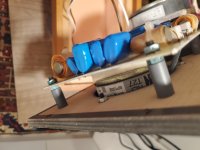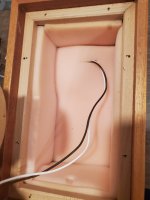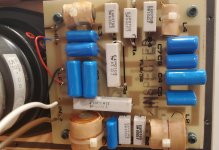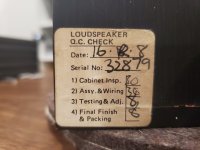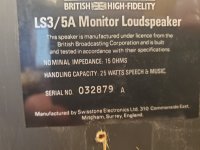Those LS3/5As were never intended as hifi speakers like said. If you want to use them today for hifi you want a sub and dsp with it to fix the low end and flatten the response. The drivers at their time were top level, but tech moved on since the 1970's. It's a +50 years old design so don't expect modern specs from it.
If i would make similar speakers today i would use other drivers, more something like the SB26ADC and a good 6 or 7" midbass like the Dayton RS180 or the SB17 midbasses. And still keep it sealed thin wall mass damped, and use a subwoofer below.
If i would make similar speakers today i would use other drivers, more something like the SB26ADC and a good 6 or 7" midbass like the Dayton RS180 or the SB17 midbasses. And still keep it sealed thin wall mass damped, and use a subwoofer below.
Last edited by a moderator:
I'd be rather careful about that; the LF response was designed for a particular purpose -partly loading the intended environment, but also as noted from the BBC's work on acoustical scaling; if you flatten out / damp the bottom end, they will simply sound like they have no LF at all, whereas in practice -they actually do sound like they have some. It's a psychoacoustic trick in applying gain to the first harmonic of fundamental notes, but a useful one for small speakers. Not without its own issues, but within the intended context, it works. I'm not a big fan of the speaker for home audio (IMO it's had its day) but from a design perspective it's still a very carefully created and often quite subtle piece of engineering.If you want to use them today for hifi you want a sub and dsp with it to fix the low end and flatten the response.
That's a Falcon crossover. Is this speaker made after 1987 or there's a chance it has been updated at a point? What year is written on the production labels at the back of the cabinets?They're in great shape inside!
"LS3/5A, FL6/38 New system using B110C - SP1228 & T27 - SP 1032
No. 101 Series Falcon component sets. Iron Dust Inductors, Polypropylene caps (Solen or ClarityCaps) and BBC designed resistive 'T' section HF attenuation."
"The B110C SP1228 - Redesign of the B110A and B with a much more consistent Bextrene cone back damped with Plastiflex PVA coating, PVC surround in a 6 ohm version used exclusively for the 1987 and later 11 ohm LS3/5a designs with a new generation LS3/5a crossover. Considered to be the most consistent to make B110 by KEF although they did eventually cease major production by the late 1990's."
I found the above info at Falcon's and in a very old Speaker Asylum post.
The drivers at their time were top level, but tech moved on since the 1970's. It's a +50 years old design so don't expect modern specs from it.
The drivers were not top level at the time. They were manufactured in large numbers, the midrange frame is stamped steel and known to resonate, the cone is resonant plastic requiring hand applied damping which was inconsistent, the tolerances were wide requiring testing and matching for higher quality speakers, etc... They were standard range drivers equivalent to something like the SEAS Prestige, Scan-Speak Discovery, SB Acoustics NRX and similar today. Not budget but not top of the range.
The high value placed on them by some for music reproduction is fascinating to observe if somewhat baffling. I suspect that pointing out that similar sized speakers with a bit higher technical performance can be put together today using modern parts for modest prices is rather missing the point. This cannot be what is valuable about them for enthusiasts. Can modern parts be used to provide what is valued? I don't know but suspect possibly not. Interesting though.
Those KEF drivers weren't much great by themselves. Greatly talented were the British loudspeaker designers of that era who had easy access to those parts and used them well.
Back in the early 80s I remember that few units choices were available in retail here. Philips & Pioneer for Hi-Fi and Celestion, RCF, Motorola for clubs were the most common in main electronics stores. Nonetheless KEF Constructor Series units were available in the KEF loudspeakers importer's store.
I went there a couple of times. I listened to the 105 the 103 the 101. I liked the 105 best needless to say.
No money for top of the line KEF or B&W speakers of course. I bough pairs of SP1057 & SP1032 instead. 🙂
Then I went to a wood merchant and he cut chipboard panels for me. They had 18mm thickness I think. I sloppily put together a pair of 10 liters closed boxes. For better bass I thought (B110 leaflet's max volume), slapped iron-on mahogany veneer, varnished them with a paintbrush.
I found a crossover schematic from a magazine. They just copied from theory and KEF info papers. Third order textbook lowpass with an RC against B110's voice coil impedance rise and acoustic Butterworth highpass for the T-27. After the air core coils I ordered from a transformers small workshop were ready, I put them together with some yellow German MKT axial capacitors from a general electronics store on a home etched crossover board that I had drawn, and my first DIY loudspeaker pair was making noises. Woohoo!
I went there a couple of times. I listened to the 105 the 103 the 101. I liked the 105 best needless to say.
No money for top of the line KEF or B&W speakers of course. I bough pairs of SP1057 & SP1032 instead. 🙂
Then I went to a wood merchant and he cut chipboard panels for me. They had 18mm thickness I think. I sloppily put together a pair of 10 liters closed boxes. For better bass I thought (B110 leaflet's max volume), slapped iron-on mahogany veneer, varnished them with a paintbrush.
I found a crossover schematic from a magazine. They just copied from theory and KEF info papers. Third order textbook lowpass with an RC against B110's voice coil impedance rise and acoustic Butterworth highpass for the T-27. After the air core coils I ordered from a transformers small workshop were ready, I put them together with some yellow German MKT axial capacitors from a general electronics store on a home etched crossover board that I had drawn, and my first DIY loudspeaker pair was making noises. Woohoo!
...Easy to drive, forward and detailed, not harsh, but for some reason they weren't as balanced as my Celef Domestic I Improved. Not enough mid-bass. The magazine published crossover's author didn't have a clue about BSC (baffle step correction) as we would say today.
But my buddy the rocker liked the clarity and he was interested if we could add some serious bass. He had sorry state 70s all cones Pioneer speakers. Alright, DIY subwoofer time. Single bass reflex cabinet, 100 liters, 12 inch soft surround paper cone! Mono sum textbook passive croossover. Back to the wood merchant and to the transformers shop, then to glue, put same reddish-brown veneer and varnish it, ready. Don't know what loudspeaker spirit blessed us but the blend came out fine this time. A very enjoyable, extended, loud and sweet, well imaging satellites & sub system. All driven by a strong Nikko integrated amp. We played tons of records through them in our teens. He kept the DIY speakers for many many years.
But my buddy the rocker liked the clarity and he was interested if we could add some serious bass. He had sorry state 70s all cones Pioneer speakers. Alright, DIY subwoofer time. Single bass reflex cabinet, 100 liters, 12 inch soft surround paper cone! Mono sum textbook passive croossover. Back to the wood merchant and to the transformers shop, then to glue, put same reddish-brown veneer and varnish it, ready. Don't know what loudspeaker spirit blessed us but the blend came out fine this time. A very enjoyable, extended, loud and sweet, well imaging satellites & sub system. All driven by a strong Nikko integrated amp. We played tons of records through them in our teens. He kept the DIY speakers for many many years.
Thank goodness for that. Which similarly sized hifi speakers available in the mid 1970s met the accuracy requirements for the intended purpose?Those LA3/5A's were never intended as hifi speakers
Caveat: former JR149 owner.
I don't know what to make of the Date on the label?
The trace side of the crossover PCB has 1987 printed on it!
I will inquire about where and when he purchased them! used or new etc..
The trace side of the crossover PCB has 1987 printed on it!
I will inquire about where and when he purchased them! used or new etc..
Attachments
Last edited:
The high value placed on them by some for music reproduction is fascinating to observe if somewhat baffling
Well said.
dave
It takes Indiana Jones to decipher that date code.I don't know what to make of the Date on the label?
The trace side of the crossover PCB has 1987 printed on it!
I will inquire about where and when he purchased them! used or new etc..
In any case with that drivers and crossover set it owes to be an 11Ω version, not 15Ω as on their black labels.
I would very strongly suggest you go find a place where you can listen to a set and decide for yourself. Unless you like listening to constant farting noises endemic in most contemporary music, you will likely miss nothing. They have wonderful sound and surprising amount of bass for such small speakers, even if not up to window shaking! They can also be augmented with a subwoofer if you feel you really miss any bass.
From the label, the cabinets were the Swisstone assembled models (a shelf-trading company bought to allow ex-Rogers employees to buy Rogers' assets from the official receiver after it went under). The speakers, given the B110 driver number (SP1228) are presumably an ista-bitsa with the later 11ohm drivers & Falcon FL6/38 crossover added -possibly somebody refreshed the damping at the same time, if the boxes didn't come with any, or they simply felt so-inclined. A lot of LS3/5a speakers have been put together in that way, recycling cabinets, drivers etc. if something went pear-shaped with the originals.
Last edited:
A lot of LS3/5a speakers have been put together in that way, recycling cabinets, drivers etc. if something went pear-shaped with the originals.
Exactly what i did for the restoration of Demetri’s pair. Comparison to an original set had the 2 pretty much the same by the reports.
dave
blu_glo said:
They can also be augmented with a subwoofer if you feel you really miss any bass.
What would you suggest is done about the raised upper bass? When low frequencies are absent the boost is likely to be preferable to a flat response but with low frequencies present?
The LS3/5A is a model for elevated mid/upper bass, reproduces the 2nd harmonic of the bas snote so well the impression that the lower note is actually there.
The Frugel-Horn Lite does this REALLY well. This becomes clear if you hook speakers with real bass up. It is interesting to watch the awe on people’s faces when they hear something with solid bottom in it.
dave
There is also a company from Calgary that purposely takes advantage of this to add SW that makes small (bluetooth) speakers seem like they have more bas sthan they do.
The Frugel-Horn Lite does this REALLY well. This becomes clear if you hook speakers with real bass up. It is interesting to watch the awe on people’s faces when they hear something with solid bottom in it.
dave
There is also a company from Calgary that purposely takes advantage of this to add SW that makes small (bluetooth) speakers seem like they have more bas sthan they do.
Last edited:
I said this a couple of posts ago.I would very strongly suggest you go find a place where you can listen to a set and decide for yourself. Unless you like listening to constant farting noises endemic in most contemporary music, you will likely miss nothing. They have wonderful sound and surprising amount of bass for such small speakers, even if not up to window shaking! They can also be augmented with a subwoofer if you feel you really miss any bass.
I have a bunch of B110's myself, used to have them with the original tweeters as well.
I don't know what the fuss is about, but the original doesn't sound pleasing at all in my opinion. A BR system sounds much better if you want to have a bit of low end. Otherwise keep them in a closed box with a proper filter and bafflestep correction. Which sounds many miles better.
In general these woofers don't sound incredible. Very vintage if you want to put some description to it. Which definitely has its charm, but it's far from being accurate.
If you ever did any measurements on them, you know why. They have a substantial amount of distortion.
I do understand a bit if the fuss if you put this into contex. These were developed in the late 70s. Most 5 inch roofers were only being used as pure mids back then. So get a much bigger range and low end out of one woofer was quite novel at the time.
The fancy and pricey status totally beats me. But it also beats me that original Mario NES are being sold for thousands of dollars.
I have them purely for nostalgic reasons.
For the same reason I like to listen to old tube radios every now and then or put on an old movie.
I read this page about putting together an LS3/5a 15Ω with Falcon drivers, Stirling thin wall cabinets, Falcon FL6/23 crossovers. What's interesting vs numerous other pages about this classic mini speaker is that it includes step by step response measurements on crossover tuning for B110's notch and T-27's level. And yes, the add on protective mesh for the T-27 does raise the last HF octave's energy. MPB's LS3/5a Project
- Home
- Loudspeakers
- Multi-Way
- Rogers LS3/5a

